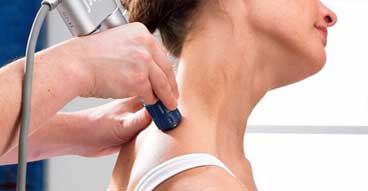Shockwave Therapy promotes healing of degenerated or injured tissue leading to reduced pain and an increase in joint function. It is clinically proven to be effective in resolving and treating a wide variety of medical conditions, such as Plantar Fasciitis, Achilles Tendonitis, Patellar Tendonitis and shin pain, tennis or golfer’s elbow, Rotator Cuff Tendonitis and Calcific, Trochanteric Bursitis, and various trigger points throughout the body. The microtrauma of the repeated shock wave to the affected area creates neo-vascularization (new blood flow) into the area and promotes tissue healing. Shockwave is also effective at breaking down calcium deposits.
It is reported that after only 2 or 3 sessions 80 percent of patients show significant reduction in pain.
Shockwave therapy reduces pain, eliminates the need for medication or surgery, promotes accelerated healing and it has proved effective for chronic conditions. It is reported that after only 2 or 3 sessions 80 percent of patients show significant reduction in pain. A therapy session lasts about 10 to 15 minutes depending on the condition that is treated. Three to five weekly sessions are usually enough to see results.
The primary effect of a pulsed wave is a direct mechanical force as the wave’s energy passes through tissue. These waves are believed to cause a controlled impact on the tissue being treated. This results in a biological reaction within the cells of that tissue (inflammation), which triggers the body to accelerate its natural healing response, and increase blood flow to the injured site.
The History of Pulsed Wave Therapy
Pulsed Wave Therapy, commonly referred to as “Shockwave” Therapy, is a relatively new form of treatment in the fields of orthopedic and rehabilitation medicine.
The effect of true “Shockwaves” was first documented during World War II when the lungs of castaways on merchant ships were noted to be damaged without any superficial evidence of trauma. It was discovered that the Shockwaves created by deep sea depth-charges were responsible for the internal injuries. This created a great deal of interest and research into the bi ological effects of Shockwaves on living tissue. The first medical treatment developed from this research was lithotripsy. This allowed “Focused” Shockwaves to specifically target and essentially dissolve kidney stones without surgical intervention. Today, over 98% of all kidney stones are treated with this technology.
The use of a modified “Radial version of Shockwaves to treat tendon related pain began in the early 195Os.
Is it safe?
Yes. All studies done to date show that when Pulsed Wave Therapy is used for the appropriate conditions there are no negative health effects. However, there are certain conditions where Pulsed Wave Therapy is not recommended. These include coagulation disorders, therapy over cancerous regions or tumors, children in a growth stage and pregnancy. For this reason we take special care to assess your individual condition and medical history.
How long does it take?
Typical treatments last 5 minutes per area that we are treating. In that time we typically deliver about 2000 pulses. Most conditions require multiple treatments spaced several days apart to allow your body to do its natural healing in between sessions.
During your initial assessment our team will evaluate your specific condition to determine how many treatments you will need.
Immediate results
- Unlike many other forms of therapy, with Pulsed Wave Therapy you will usually notice immediate results. These often include:
- A significant reduction in pain
- An increase in your range of motion, improved mobility
- Your muscle tone is normalized
- Previously noticeable “knots” or tightness have become relaxed
Does it hurt?
If your treatment is on a “fleshy” area, you are not likely to feel any discomfort at all. Treatments on “boney” regions tend to be more sensitive. Your first treatment may be uncomfortable at first but most patients find it tolerable. As your body heals, you will find each successive treatment easier.
If you are especially sensitive, adjustments on the Pulsed Wave machine can decrease the discomfort you feel. We use a device called the Zimmer enPuls specifically because it delivers a patented “Soft Shot” pulse which is much less likely to cause discomfort during treatment.
What can be treated with Radial Pulsed Wave?
- Pulsed Waves are used to treat many orthopedic conditions, including:
- Plantar fasciitis (heel spurs)
- Chronic Inflammation
- Patellar tendonitis (jumper’s knee)
- Bursitis
- Lateral epicondylitis (tennis elbow)
- Shin splints
- Medial epicondylitis (golfer’s elbow)
- Morton’s Neuroma
- Thumb basal joint Arthritis
- Stress Fractures
- Shoulder Tendonitis
- Osteoarthritis


